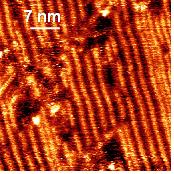


We discovered in 2002 (JACS 124, 9998, 2002) that the linear multifunctional trimethylsilyl-acetylene 1 ,TMSA, (schema 1) forms long-range and highly stable self-assembled monolayers (SAMs) on reconstructed Au(111). In order to better understand the interactions governing self-assembly in this new system, we synthetized a series of homolog organosilanes and performed STM observations at the Au(111)/n-tetradecane interface.
The four TMSA-terminated linear silanes that we synthetized self-assemble similarly to 1 on gold, with molecules standing upright on the surface. On the contrary, compounds 2 and 3 possess a slightly modified terminal group and do not self-assemble. In particular, substituting a methyl group of TMSA by a bulky tertio-butyl group prevents self-assembly. Removing the C≡C triple bond of TMSA or substituting the Si atom by a C one also hinders self-assembly. Finally, substituting one methyl group of TMSA by an hydrogen atom (compound 4) induces self-assembly but in a different geometry, with molecules lying flat on the gold surface in a quasi-epitaxy mode.

STM image (4040 nm2 ; It=189 pA; Ut=0.553 V) of the lamellae formed by compound 4 adsorbed on gold.
Our molecular approach demonstrates the key role played by the TMSA head in self-assembly, its origin being twofold: (i) the TMSA overlayers are commensurate to the Au(111) lattice along the <112> direction, and (ii) the C≡C triple bond of TMSA activates the Si atom and induces the creation of a surface Si-Au chemical bond. The highly stable TMSA-based SAMs appear then as promising materials for applications in surface modification.
Finally, we now extend this study by replacing the Si atom of the TMSA group into other elements of column IVA such as carbon (TMCA), Ge (TMGA) and Sn (TMSnA). For example, preliminary results show that compounds 5 and 6 self-assemble into lamellae with molecules lying flat on the substrate.
N. Katsonis, A. Marchenko, S. Taillemite, D. Fichou, G. Chouraqui, C. Aubert and M. Malacria, Chem. Eur. J. 9, 2573-2581, 2003
•  Électronique et optique du futur › Matériaux pour l'électronique et l'optique - Electronique organique et moléculaire
Électronique et optique du futur › Matériaux pour l'électronique et l'optique - Electronique organique et moléculaire
• Laboratory of Physics and Chemistry of Surfaces and Interfaces • Service de Physique et Chimie des Surfaces et des Interfaces
